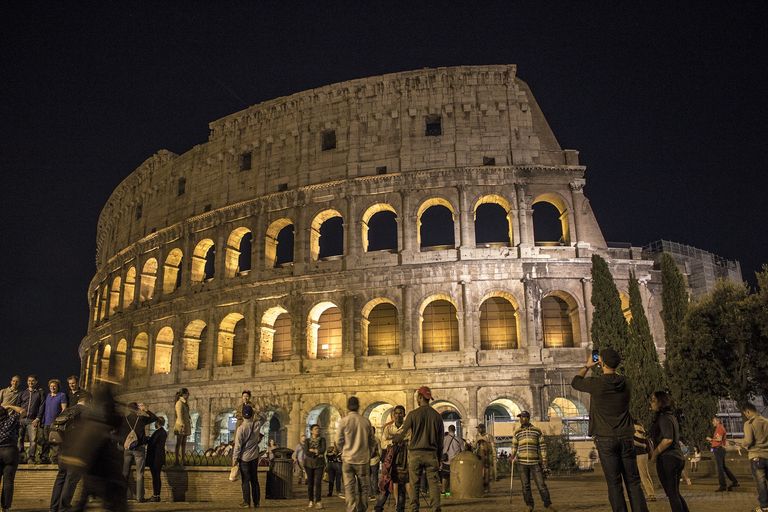
The Coronavirus epidemic, or COVID-19 as it is scientifically called, forced us, at the time, to change our routines and living habits. Let us hope that such a situation will not occur again, although there are some indications of contagions in various parts of the world.
In any case, the vaccinations we have taken should be enough to significantly reduce the effects.
Apart from all the recommended precautions, the main one was isolation, avoiding the concentration of large groups of people.
In simple words: everybody go home. And at home we will try to do everything we do not do when we can move freely without any restrictions: reading, researching, listening to music, developing a hobby - in my case philately and bonsai -, spending more time on the computer, watching television, and so on.
Everyone chose the hobby of their choice.
In my case, I chose to remember many images of Italy, the country where I lived for many years of my life and which was the country hardest hit in Europe by the pandemic, with a total number of verified cases exceeding 20,000, especially affecting the elderly population which, in Italy, is the majority.
When I see the deserted Piazza di San Pietro, the Colosseo or Venezia on television, it seems a surreal image to me.
That is why I have tried to remember something of those places that until recently were teeming with tourists and life. Then they had been transformed into a desert of living beings. And now, little by little, it has begun to resume its usual rhythm.

La epidemia de Coronavirus o COVID-19 como se lo llamado científicamente nos obligó, en su momento, a cambiar nuestras rutinas y hábitos de vida. Esperemos que una situación del género no se vuelva a presentar, aunque hay algunos indicios de contagios en diversas partes del mundo.
De cualquier manera las vacunas que nos hemos aplicado deberían ser suficientes para disminuir sensiblemente sus efectos.
Aparte de todas las prevenciones recomendadas el principal fue el aislamiento, evitar la concentración de grandes grupos de personas.
En palabras simples: todos a casa. Y en casa trataremos de hacer todo lo que no hacemos cuando podemos circular libremente sin ningún tipo de restricciones: leer, investigar, escuchar música, desarrollar algún hobby -en mi caso la filatelia y el bonsai-, pasar más tiempo con el ordenador, mirar televisión, etc.
Cada uno elegía el pasatiempo u hobby de su preferencia.
En mi caso opté por recordar numerosas imágenes de Italia país en el que viví muchos años de mi vida y que fue el país más golpeado en toda Europa con la pandemia, con un número total de casos verificados superior a 20.000, afectando especialmente la población anciana que, en Italia, es mayoría.
Cuando veo en la televisión la Piazza di San Pietro, el Colosseo o Venezia desiertos me parece una imagen surrealista.
Por ese motivo he tratado de recordar algo de esos lugares que hasta hace poco pululaban de turistas y vida. Luego se habían transformado en un desierto de seres viovientes. Y ahora de a poco ha comenzado a retomar su ritmo habitual.

The Roman Colosseum. / El Coliseo Romano.
The Roman Colosseum is a symbol of the Roman Empire. Then, as now, it continues to amaze for its majesty and for what happened there. And then, as now, it is surrounded by myths, legends and curiosities.
The Roman Colosseum is one of those buildings that anyone can identify, even if they have never visited it. It is a universal symbol. Even a notorious CD burning software (Nero Burning) has in its icon the Colosseum in flames (in this case the word ‘burn’ equals ‘burn’).
At an imposing 189 metres long and 156 metres wide (one and a half football stadiums) the Colosseum has a perimeter of 527 metres and a capacity to hold 50,000 spectators.

El Coliseo Romano es todo un símbolo de la época del Imperio Romano. Antes como ahora sigue sorprendiendo por su majestuosidad y por lo que ahí sucedía. Y también antes, como ahora, está rodeado por un halo de mitos, leyendas y curiosidades.
El Coliseo Romano es uno de esos edificios que cualquier persona puede identificar, incluso si jamás lo ha visitado. Es un símbolo universal. Hasta un notorio software para grabar CD (Nero Burning) tiene en su icono el Coliseo en llamas (en este caso la palabra grabar se iguala a "quemar").
Con sus imponentes 189 metros de largo y 156 metros de ancho (un estadio y medio de fútbol) el Coliseo tiene un perímetro de 527 metros y una capacidad para albergar a 50.000 espectadores.
World Heritage Site. / Patrimonio de la Humanidad.
As well as being one of the Seven Wonders of the Modern World, it was declared a UNESCO World Heritage Site in 1980.
Its peculiar shape and fascinating history have made it a symbol of history.
For this reason we review some of the most surprising facts and figures about this spectacular amphitheatre from the Roman Empire.

Además de formar parte de las Siete Maravillas del Mundo Moderno, fue declarado Patrimonio de la Humanidad por la Unesco en 1980.
Su peculiar forma y su fascinante historia lo han convertido en todo un símbolo de la historia.
Por tal motivo repasamos algunos de los hechos y datos más sorprendentes de este espectacular anfiteatro de la época del Imperio Romano.
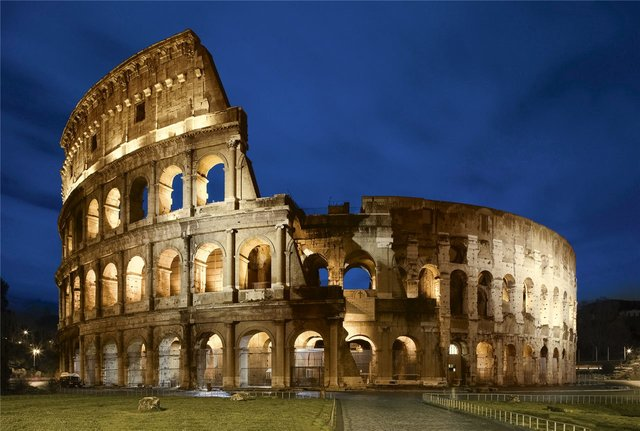
The Flavian amphitheatre.
The construction of what is now known as the Roman Colosseum was begun by order of Emperor Vespasian between 70 and 72 AD.
It was completed by his son Titus in 80 AD.
Its original name was the Flavian Amphitheatre (Amphitheatrum Flavium), after the Flavian dynasty of the emperors who built it.
It was later renamed Colosseum because of the large statue of Nero's Colossus that stood near the building but is not preserved today. Other sources claim a different origin of the name.
The Flavian amphitheatre. / El anfiteatro de los Flavios.
The construction of what is now known as the Roman Colosseum was begun by order of Emperor Vespasian between 70 and 72 AD.
It was completed by his son Titus in 80 AD.
Its original name was the Flavian Amphitheatre (Amphitheatrum Flavium), after the Flavian dynasty of the emperors who built it.
It was later renamed Colosseum because of the large statue of Nero's Colossus that stood near the building but is not preserved today. Other sources claim a different origin of the name.

La construcción del hoy conocido como Coliseo Romano se inició por mandato del emperador Vespasiano entre el 70 y 72 d. C.
Fue terminado por su hijo Tito en el año 80 d. C.
Su nombre original era Anfiteatro Flavio (Amphitheatrum Flavium), en honor a la dinastía flavia de los emperadores que lo construyeron.
Más tarde pasó a llamarse Colosseum debido a la gran estatua el Coloso de Nerón que estaba cerca del edificio pero que no se conserva hoy en día. Otras fuentes sostienen un origen del nombre distinto.
The mystery of the name. / El misterio del nombre.
For centuries it has been known as the Colosseum, although its real name is the Flavian Amphitheatre. Some writers and historians claim that the name derives from ‘colossus’, a gigantic bronze statue dedicated to Nero.
The historian Armannino Giudice who lived in the 4th century A.D. claims instead that the name derives from the question that was asked to each of the members of the demonic sects that gathered there: ‘Colis Eum?’ i.e. ‘Do you worship him?’

Desde hace siglos es conocido como Coliseo aunque su verdadero nombre es Anfiteatro Flavio. Algunos escritores e historiadores sostienen que el nombre deriva de "coloso", una estatua gigantesca de bronce dedicada a Nerón.
El historiador Armannino Giudice que vivió en el siglo IV d.C sostiene en cambio que el nombre deriva de la pregunta que se le efectuaba a cada uno de los integrantes de las sectas demoníacas que se reunían en el lugar: "Colis Eum?" es decir "Adoras a él?"
A spectacular inauguration. / Una inauguración espectacular.
The general idea we have of the use of this enormous arena is that of gladiatorial combat, Christian sacrifice and animal fighting.
Although some anecdotes are not entirely correct, it is true that the magnitude of our imaginations is not gratuitous.
To give an example: at the inauguration of the Colosseum, which took 100 days of festivities, hundreds of gladiators and around 9,000 wild animals lost their lives.

La idea generalizada que tenemos del uso de esta enorme arena es el de la lucha de gladiadores, el sacrificio de cristianos y la pelea de animales.
Aunque algunas anécdotas no son del todo correctas lo cierto es que la magnitud de nuestras imaginaciones no es gratuita.
Pongamos un ejemplo: en la inauguración del Coliseo que tomó 100 días de festejos perdieron la vida cientos de gladiadores y alrededor de 9.000 animales salvajes.
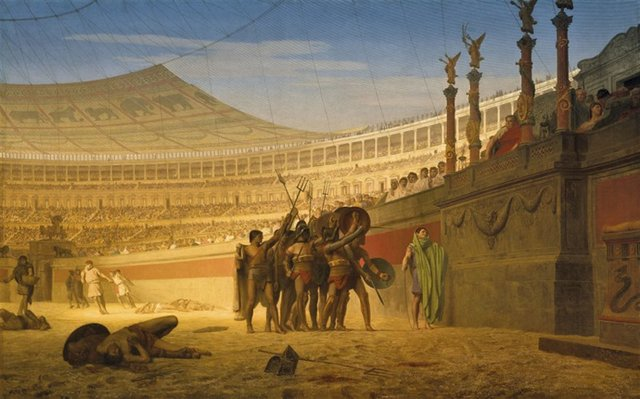
Naval battles: a legend with a small dose of truth / Batallas navales: una leyenda con una mínima dosis de verdad.
One of the most popular myths about the Colosseum is related to the naval battles that supposedly took place in the arena, where the stage was filled with water and the so-called naumachias took place.
However, this is only a half-truth, as it is known that a naval battle took place only during the inauguration festivities (i.e. those amazing 100 days), but not in later times.
This hypothesis is supported by the existence of rooms, dressing rooms and other underground rooms underneath the large wooden stage and arena that existed, and by images that could testify to this exceptional event.

Uno de los mitos más populares sobre el Coliseo es el relacionado con las batallas navales que supuestamente se disputaban en el recinto, en donde se llenaba de agua el escenario y tenían lugar las llamadas naumaquias.
Sin embargo, estamos ante una verdad a medias pues se sabe que sólo en los festejos de inauguración (es decir, esos sorprendentes 100 días) tuvo lugar una batalla naval pero no en tiempos posteriores.
Esta hipótesis se sostiene con la existencia de cuartos, vestidores y demás habitaciones subterráneas, debajo del gran escenario de madera y arena que existía. y de imágenes que podrían atestiguar este hecho excepcional.
The gladiators. / Los gladiadores.
One of the regular spectacles that took place in the Colosseum was that of the gladiators, fighters who entertained the public with their violent confrontations, often to the death, against other gladiators, but also with wild beasts and those condemned to death.
Most of the gladiators were criminals, slaves or prisoners of war. Gladiatorial schools were built around the Colosseum. It was not until the 5th and 6th centuries that gladiator and wild animal fights were banned.

Uno de los espectáculos regulares que se daban lugar en el Coliseo era el de los protagonizados por los gladiadores, combatientes que entretenían al público con sus confrontaciones violentas, y muchas de las veces a muerte, contra otros gladiadores pero también con fieras y condenados a muerte.
La mayoría de los gladiadores eran criminales, esclavos o prisioneros de guerra. Alrededor del Coliseo se construyeron escuelas de gladiadores. Fue hasta los siglos V y VI que se prohibieron las luchas de gladiadores y de animales salvajes.
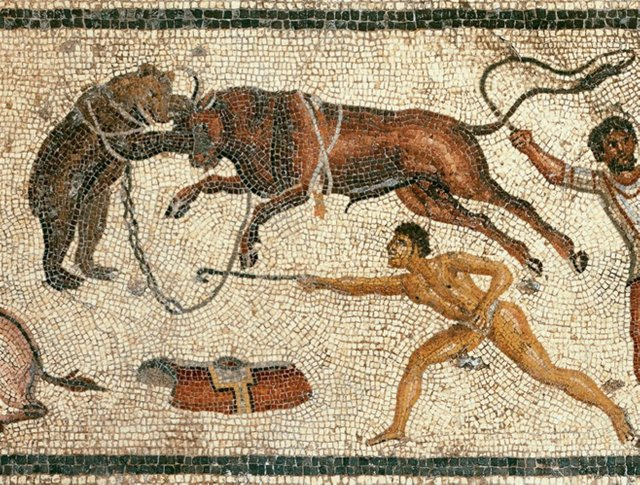
Torment of the Christians / Tormento de los cristianos.
Although it is also believed that the Colosseum was the scene of numerous Christian sacrifices, the truth is that these took place mostly in other arenas and stadiums.
However, this idea led to the Colosseum being preserved in later times because it was considered a sacred place, thus avoiding the looting that the building had already suffered, and even in the 19th century several popes ordered repairs and restoration work to be carried out on the building.

Aunque también se cree que en el Coliseo fue escena de numerosos sacrificios de cristianos, lo cierto es que éstos tuvieron lugar mayormente en otras arenas y estadios.
Sin embargo, esta idea propició que el Coliseo se conservara en tiempos posteriores pues se le consideró como un lugar sagrado, evitándose así el saqueo que ya había sufrido el edificio e, incluso, en el siglo XIX varios papas mandaron realizar trabajos de reparación y restauración del edificio.
The first lifts in history. / Los primeros ascensores de la historia.
To transport the animals from the underground cages to the arena, the Romans had developed an ingenious system of hoists capable of transporting up to 10 animals at a time.
Apart from the wild beasts, these underground cages were inhabited by prisoners of war and slaves who were often used in combat.

Para conducir los animales desde las jaulas subterráneas hasta la arena los romanos habían desarollado un ingenioso sistema de montacargas en grado de trasferir hasta 10 animales por vez.
En estos subterráneos habitaban aparte d elas fieras, los prisioneros de guerra y esclavos usados muchas veces para combatir.
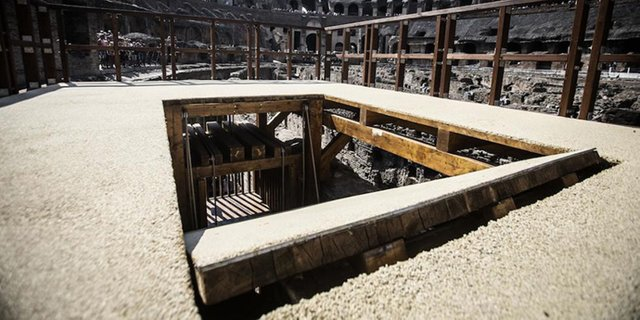
/ Reconstrucción fiel de uno de los 28 elevadores de carga que entre fines del siglo I d. C. y principios del siglo III d. C. se utilizaron para llevar bestias y animales del subsuelo a la arena del Coliseo.
The Colosseum today. / El Coliseo en la actualidad.
As we said at the beginning, this building is a symbol and a tourist attraction of Rome.
Thousands of tourists visit the building every year with the interest to enter and see the arena and imagine, of course, the spectacular battles that took place there.
It now houses a museum dedicated to the Greek god Eros.
A curious note is the constant increase in the number of visitors. In 1998, with admission at €3.98 (actually only for statistical purposes because it cost 7,700 Italian lire), 2,811,076 people visited the Colosseum.
Twenty years later, in 2018, 7,665,000 people visited the Colosseum, Roman Forum and Palatine Hill, an increase of almost 200%. Even with the price of admission more than doubling (€9.75).
Thus generating a daily income for the Comune di Roma of € 204,750. That is what the Eternal City loses for each day the Colosseum is closed. Plus the other income from various concessions.

Como decíamos al principio, este edificio es todo un símbolo y también una atracción turística de Roma.
Miles de turistas visitan el edificio cada año con el interés de entrar y ver la arena e imaginar, cómo no, las espectaculares batallas que ahí tuvieron lugar.
En la actualidad alberga un museo dedicado al dios griego Eros.
Una nota curiosa es el constante aumento de visitadores. En el año 1998 con la entrada a € 3,98 (en realidad solo con fines estadísticos porque costaba 7.700 liras italianas) visitaron el Coliseo 2.811.076 personas.
Veinte años más tarde, en el 2018, ingresaron en el circuito turístico Coliseo, Foro romano y Palatino 7.665.000 personas, registrando un aumento cercano al 200%. Aún con el precio de la entrada a más del doble (€ 9,75).
Generando de esta manera un ingreso diario al Comune di Roma de € 204.750. Eso es lo que pierde la Ciudad Eterna por cada día que tiene el Coliseo cerrado. Más los demás ingresos por concesiones varias.
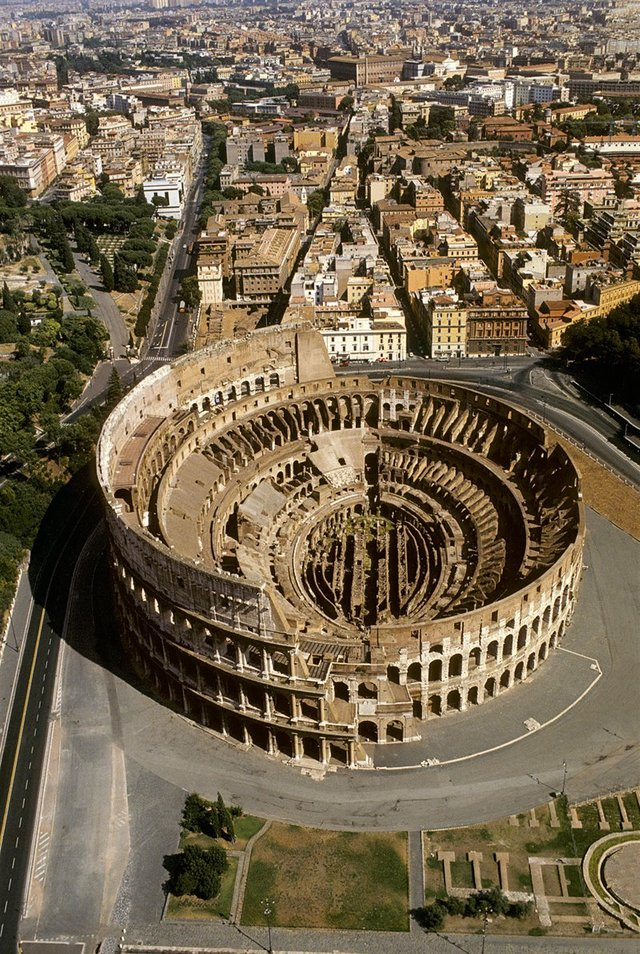
/ Fotografía aérea del Coliseo romano en la actualidad.
A very special botanical garden. / Un jardín botánico muy especial.
More than 350 different species of plants have spontaneously populated the ruins of the Colosseum, many of them of exotic origin.
According to some writers the original seeds would have been brought by wild animals from Africa or Asia or even in the very feet of the prisoners.
Their development in a country with no tropical climate at all can be explained by the particular microclimate of the area.

Más de 350 especies de plantas diversas han poblado espontáneamente las ruinas del Coliseo, muchas de ellas de origen exótico.
Según algunos escritores las semillas originales habrían sido traídas por los animales salvajes de Africa o Asia o incluso en los mismos pies de los prisioneros.
Su desarrollo en un país que no tiene nada de clima tropical se explica en el particular microclima del área.
Source initial image / Fuente imagen inicial: Pixabay by BKD
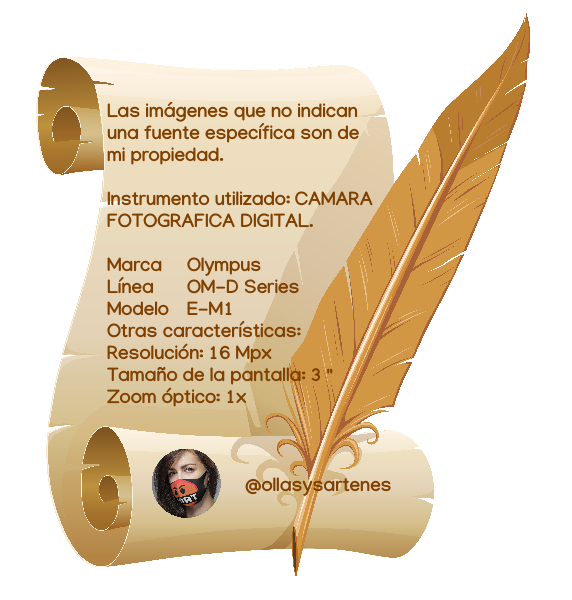

El presente artículo puede haber sido publicado parcial o totalmente en algunos de mis blogs.
This article may have been published in part or in full on one of my blogs.
Mis Blogs y Sitios Web / My Blogs & Websites:
- La Cucina di Susana.
- Cucinando con Susana
- El Mundo de los Postres
- Crónicas de Un Mundo en Conflicto.

Upvoted. Thank You for sending some of your rewards to @null. Get more BLURT:
@ mariuszkarowski/how-to-get-automatic-upvote-from-my-accounts@ blurtbooster/blurt-booster-introduction-rules-and-guidelines-1699999662965@ nalexadre/blurt-nexus-creating-an-affiliate-account-1700008765859@ kryptodenno - win BLURT POWER delegationNote: This bot will not vote on AI-generated content
Thanks @ctime!